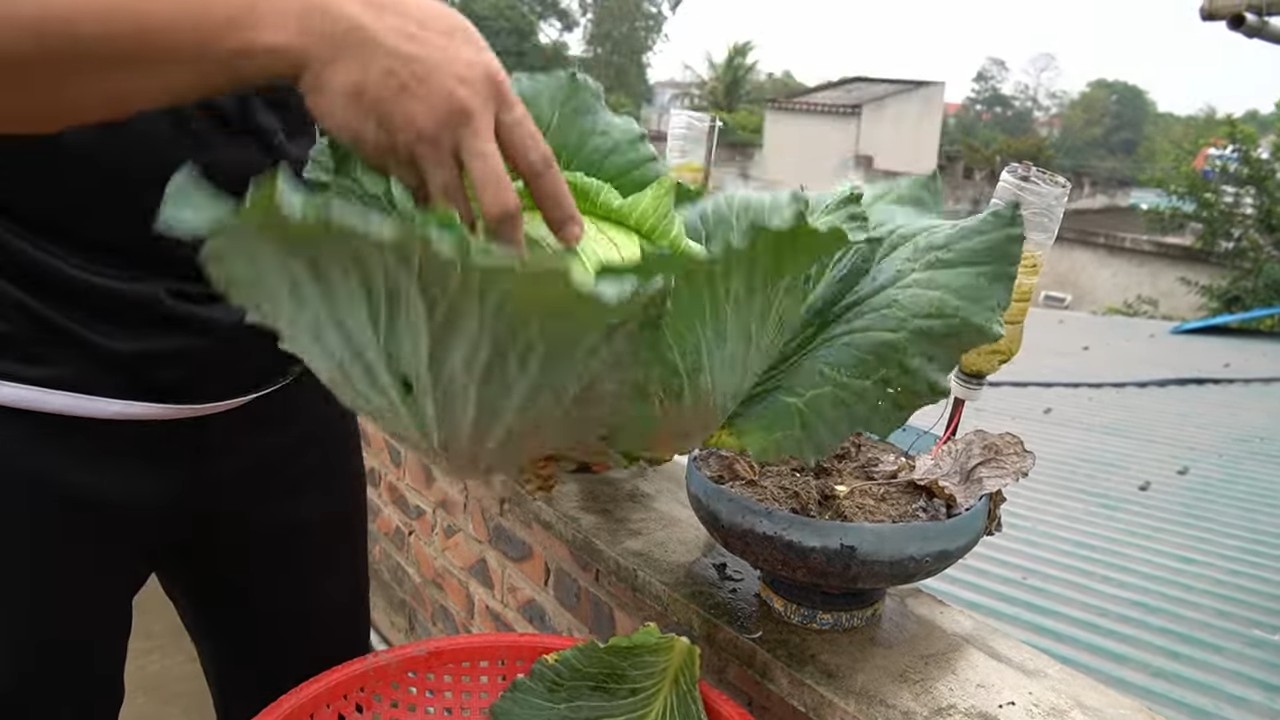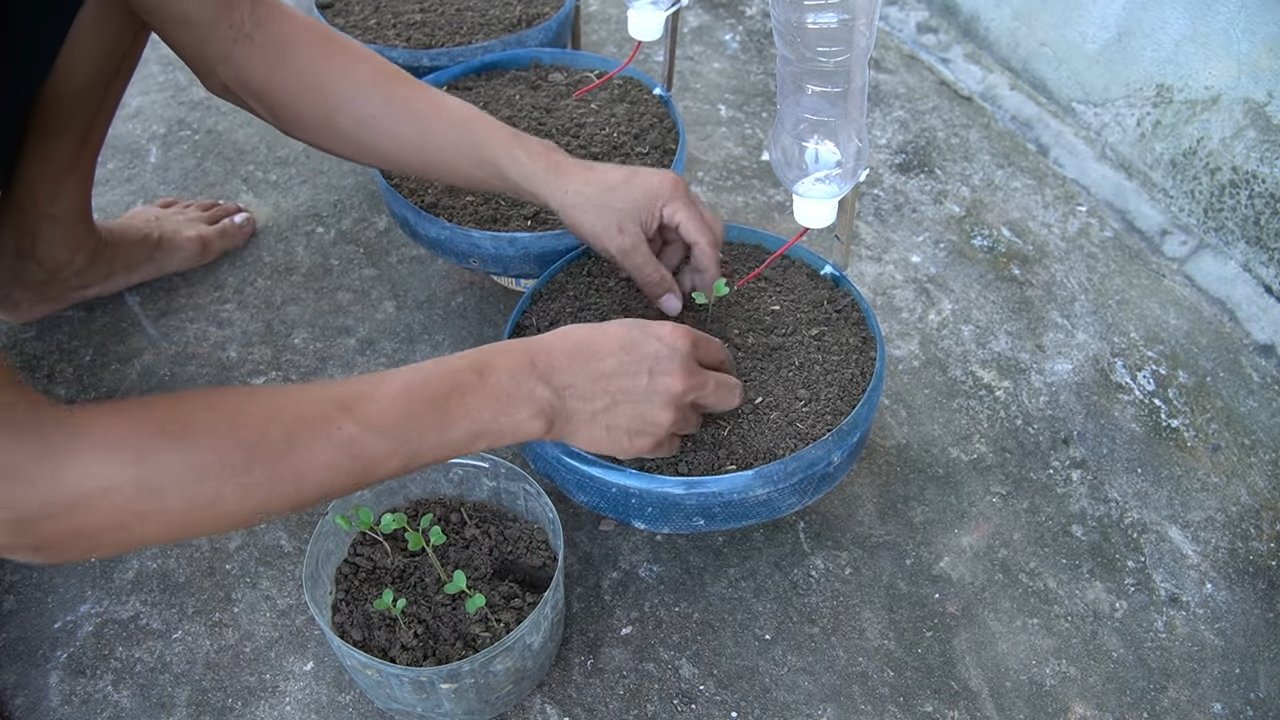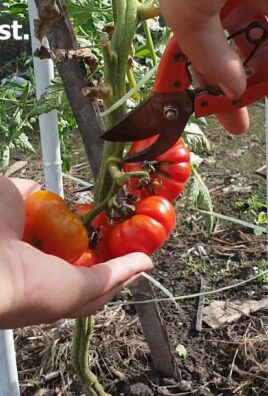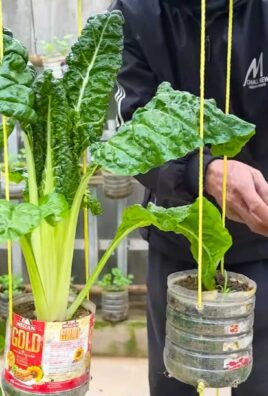Growing Cabbage in Small Spaces might seem like a challenge reserved for sprawling farms, but I’m here to tell you it’s absolutely achievable, even if your “garden” is a sunny balcony or a tiny patio! Forget the image of endless rows; we’re talking about maximizing your yield in a minimal footprint.
For centuries, cabbage has been a staple in diets across the globe, from the hearty stews of Eastern Europe to the vibrant slaws of North America. Its resilience and nutritional value have made it a beloved crop. But what if you don’t have acres of land to dedicate to this leafy green? That’s where these clever DIY tricks come in!
Let’s face it, fresh, homegrown produce tastes infinitely better than anything you can buy at the store. Plus, knowing exactly where your food comes from and how it was grown is incredibly satisfying. But space constraints often deter aspiring gardeners. That’s why I’m so excited to share these simple, effective methods for growing cabbage in small spaces. Imagine harvesting your own crisp, flavorful cabbage heads, ready to be transformed into delicious meals, all from your own little urban oasis. This article will equip you with the knowledge and techniques to successfully cultivate cabbage, no matter how limited your gardening area may be. Get ready to unleash your inner green thumb!

Growing Cabbage in Small Spaces: A Beginner’s Guide
Hey there, fellow garden enthusiasts! So, you’re dreaming of fresh, homegrown cabbage but think you don’t have the space? Think again! I’m here to tell you that growing cabbage in small spaces is totally achievable, even if you only have a balcony, patio, or a tiny corner of your yard. It just takes a little planning and the right techniques. Let’s dive in!
Choosing the Right Cabbage Variety
First things first, not all cabbages are created equal when it comes to space requirements. Some varieties are massive, while others are more compact and perfect for container gardening. Here’s what I recommend:
* Early Varieties: These mature faster and tend to be smaller overall. Think ‘Early Jersey Wakefield’ or ‘Golden Acre.’ They’re great for a quick harvest and won’t hog all the space.
* Dwarf Varieties: As the name suggests, these are bred to be smaller. Look for varieties like ‘Dwarf Blue Vates’ or ‘Gonzales.’
* Consider Head Size: Pay attention to the expected head size listed on the seed packet or plant label. Smaller heads mean less space needed.
Preparing Your Growing Space
Okay, now that we’ve picked our cabbage champions, let’s get our growing space ready. This is crucial for success!
* Container Size: This is super important! Each cabbage plant needs at least a 12-inch diameter pot, and preferably a 14-16 inch one. The bigger, the better, as it allows for more root growth and better water retention.
* Drainage: Make sure your container has drainage holes! Cabbage hates sitting in soggy soil. If your container doesn’t have enough holes, drill a few more.
* Soil: Cabbage loves rich, well-draining soil. I recommend a mix of:
* Potting mix (this provides good aeration)
* Compost (for nutrients and water retention)
* A little bit of perlite or vermiculite (to improve drainage)
* Sunlight: Cabbage needs at least 6 hours of sunlight per day. Choose a spot that gets plenty of sunshine. If you’re growing indoors, you’ll need grow lights.
Planting Your Cabbage
Alright, time to get our hands dirty! You can start cabbage from seed or buy seedlings from a nursery. I usually prefer seedlings because it’s faster and easier, but starting from seed is definitely doable.
Starting from Seed (Optional)
1. Sow Seeds Indoors: About 6-8 weeks before the last expected frost, sow your cabbage seeds indoors in seed trays or small pots filled with seed-starting mix.
2. Keep Them Moist: Keep the soil consistently moist but not soggy.
3. Provide Light: Place the seed trays under grow lights or in a sunny window.
4. Harden Off Seedlings: Before transplanting outdoors, gradually acclimate the seedlings to outdoor conditions by exposing them to increasing amounts of sunlight and fresh air over a week or two.
Transplanting Seedlings (The Easier Route!)
1. Dig a Hole: Dig a hole in your container that’s slightly larger than the root ball of your seedling.
2. Gently Remove Seedling: Carefully remove the seedling from its container, being careful not to damage the roots.
3. Place in Hole: Place the seedling in the hole, making sure the top of the root ball is level with the soil surface.
4. Fill and Water: Fill in the hole with soil and gently pat it down. Water thoroughly.
Caring for Your Cabbage
Now comes the ongoing care. Cabbage needs consistent attention to thrive.
* Watering: Cabbage needs consistent moisture, especially during head formation. Water deeply whenever the top inch of soil feels dry. Avoid overhead watering, as this can lead to fungal diseases.
* Fertilizing: Cabbage is a heavy feeder, meaning it needs a lot of nutrients. Fertilize every 2-3 weeks with a balanced liquid fertilizer. You can also side-dress with compost or aged manure.
* Mulching: Apply a layer of mulch around the base of the plant to help retain moisture, suppress weeds, and regulate soil temperature. Straw, wood chips, or shredded leaves work well.
* Pest Control: Cabbage can be susceptible to pests like cabbage worms, aphids, and flea beetles. Here’s how I deal with them:
* Cabbage Worms: These are the bane of every cabbage grower’s existence! Handpick them off the plants whenever you see them. You can also use Bacillus thuringiensis (Bt), a natural bacteria that kills cabbage worms.
* Aphids: These tiny pests suck the sap from plants. Blast them off with a strong stream of water from the hose. You can also use insecticidal soap or neem oil.
* Flea Beetles: These tiny beetles chew small holes in the leaves. Cover your plants with row covers to prevent them from reaching the plants. You can also use diatomaceous earth.
* Weed Control: Keep the area around your cabbage plants free of weeds. Weeds compete with cabbage for water and nutrients.
Harvesting Your Cabbage
The moment we’ve all been waiting for! Knowing when to harvest is key to getting the best flavor and texture.
* Check for Firmness: The cabbage head should feel firm and solid when you squeeze it gently.
* Head Size: The head should be the size specified for the variety you’re growing.
* Cracking: If the head starts to crack, it’s overripe and should be harvested immediately.
* Harvesting Technique: Use a sharp knife to cut the cabbage head from the stem, leaving a few outer leaves attached.
Troubleshooting Common Problems
Even with the best care, things can sometimes go wrong. Here are some common problems and how to fix them:
* Yellowing Leaves: This could be a sign of nutrient deficiency, overwatering, or underwatering. Check the soil moisture and fertilize if needed.
* Stunted Growth: This could be caused by poor soil, lack of sunlight, or pest infestation. Make sure your cabbage is getting enough sunlight and nutrients, and check for pests.
* Bolting: This happens when the cabbage plant flowers prematurely, usually due to stress from heat or lack of water. Once a cabbage bolts, the head becomes bitter and inedible. To prevent bolting, keep the soil consistently moist and provide shade during hot weather.
* Splitting Heads: This is usually caused by inconsistent watering. Try to keep the soil moisture consistent, especially during head formation.
Maximizing Your Small Space
Okay, so you’re growing cabbage in a small space. Let’s make the most of it!
* Succession Planting: Plant new cabbage seedlings every few weeks to ensure a continuous harvest throughout the growing season.
* Companion Planting: Plant cabbage alongside other vegetables that benefit each other. Good companions for cabbage include:
* Marigolds: Repel nematodes and other pests.
* Nasturtiums: Attract aphids away from cabbage.
* Dill: Attract beneficial insects that prey on cabbage worms.
* Onions and Garlic: Repel cabbage moths.
* Vertical Gardening: If you have a wall or fence, consider using vertical gardening techniques to grow other vegetables alongside your cabbage.
Choosing the Right Container
Selecting the right container is crucial for successful cabbage growing in limited spaces. Here’s a breakdown of factors to consider:
* Material:
* Plastic: Lightweight, affordable, and retains moisture well. Choose BPA-free options.
* Terracotta: Porous, allowing for good aeration and drainage. Can dry out quickly in hot weather.
* Ceramic: Decorative and durable, but can be heavy. Ensure good drainage.
* Fabric Pots: Excellent drainage and aeration, promoting healthy root growth.
* Shape:
* Round: Classic and versatile.
* Square/Rectangular: Efficient use of space, especially on balconies or patios.
* Color:
* Light Colors: Reflect sunlight, keeping the soil cooler in hot climates.
* Dark Colors: Absorb sunlight, warming the soil in cooler climates.
Extending the Growing Season
Don’t let the changing seasons limit your cabbage-growing dreams! Here are some tips for extending the growing season:
* Cold Frames: These simple structures protect plants from frost and cold winds, allowing you to start growing earlier in the spring and extend the harvest into the fall.
* Row Covers: Lightweight fabric covers that protect plants from frost, pests, and harsh weather.

Conclusion
So, there you have it! Growing cabbage in small spaces isn’t just a pipe dream; it’s an achievable reality with a little planning and the right techniques. We’ve explored how to maximize your limited area, choose the perfect compact varieties, and provide the optimal growing conditions for a bountiful harvest.
Why is this DIY approach a must-try? Because it empowers you to enjoy fresh, homegrown cabbage even if you’re limited by apartment living, a small balcony, or a tiny backyard. Imagine the satisfaction of harvesting your own crisp, flavorful cabbage heads, knowing you nurtured them from seedling to table, all within the confines of your small space. Beyond the delicious reward, you’ll also experience the therapeutic benefits of gardening, connecting with nature, and reducing your reliance on store-bought produce.
But the journey doesn’t end here! Feel free to experiment with different companion plants to deter pests naturally. Try interplanting your cabbage with herbs like rosemary or thyme, or flowers like marigolds, to create a vibrant and beneficial ecosystem in your small garden. You can also explore different container types – from repurposed buckets to vertical planters – to find what works best for your space and aesthetic. Consider succession planting, staggering your planting times to enjoy a continuous harvest throughout the growing season.
Don’t be afraid to get creative with your fertilizer choices, too. While we’ve recommended balanced options, you can also explore organic alternatives like compost tea or worm castings to nourish your cabbage plants naturally. Remember to monitor your plants regularly for any signs of pests or diseases, and address them promptly to prevent them from spreading.
Ultimately, the key to successful small-space cabbage growing is observation and adaptation. Pay attention to your plants’ needs, adjust your techniques as necessary, and don’t be discouraged by setbacks. Every gardening experience is a learning opportunity, and with each season, you’ll become more adept at cultivating delicious cabbage in your limited area.
We wholeheartedly encourage you to give this DIY trick a try. Embrace the challenge, get your hands dirty, and witness the magic of growing your own food, no matter how small your space may be. And most importantly, we want to hear about your experiences! Share your photos, tips, and triumphs with us in the comments below. Let’s create a community of small-space cabbage growers, inspiring and supporting each other along the way. Your success story could be the motivation someone else needs to embark on their own gardening adventure. So, go ahead, plant those seeds, and let the cabbage growing begin! Remember, even the smallest space can yield a surprisingly abundant harvest with the right approach to growing cabbage in small spaces.
Frequently Asked Questions (FAQ)
What are the best cabbage varieties for small spaces?
Choosing the right variety is crucial for success when growing cabbage in limited areas. Look for compact or dwarf varieties that don’t require as much space to mature. Some excellent options include:
* **’Dwarf Blue Vates’:** This is a popular choice for small gardens due to its compact size and tolerance to various growing conditions. It produces small to medium-sized heads with a slightly flattened shape.
* **’Golden Acre’:** A fast-maturing variety that produces small, round heads. It’s ideal for early harvests and succession planting.
* **’Red Express’:** A beautiful red cabbage variety that is relatively compact and matures quickly. It adds a splash of color to your garden and is packed with nutrients.
* **’Savoy Ace’:** While Savoy cabbages tend to be larger, ‘Savoy Ace’ is a more compact option with crinkled leaves and a mild flavor.
Always check the seed packet or plant label for specific size and spacing recommendations for each variety.
How much sunlight does cabbage need when grown in containers?
Cabbage thrives in full sun, which means it needs at least 6-8 hours of direct sunlight per day. When growing cabbage in containers, ensure you place them in a location that receives ample sunlight. If you’re growing cabbage indoors under grow lights, provide them with at least 14-16 hours of light per day. Insufficient sunlight can lead to leggy growth, smaller heads, and reduced yields. If you live in a particularly hot climate, some afternoon shade may be beneficial to prevent the leaves from scorching.
What size container is best for growing cabbage?
The ideal container size for growing cabbage depends on the variety, but generally, a container that is at least 12 inches in diameter and 12 inches deep is recommended. This provides enough space for the roots to develop properly. Larger containers are always better, as they hold more moisture and nutrients, reducing the need for frequent watering and fertilizing. If you’re growing multiple cabbage plants in a single container, ensure there’s adequate spacing between them (at least 12 inches) to prevent overcrowding.
How often should I water my cabbage plants in containers?
Cabbage plants need consistent moisture to thrive. Water your cabbage plants regularly, especially during hot and dry weather. Check the soil moisture by sticking your finger about an inch deep into the soil. If it feels dry, it’s time to water. Water deeply until the water drains out of the bottom of the container. Avoid overwatering, as this can lead to root rot. A good rule of thumb is to water every 2-3 days, but adjust the frequency based on the weather and the moisture level of the soil.
What type of fertilizer should I use for cabbage?
Cabbage is a heavy feeder, meaning it requires a good supply of nutrients to grow well. Use a balanced fertilizer with an NPK ratio of 10-10-10 or 14-14-14. You can also use organic fertilizers like compost tea, worm castings, or fish emulsion. Apply fertilizer every 2-3 weeks, following the instructions on the product label. Avoid over-fertilizing, as this can burn the roots and damage the plants.
How do I protect my cabbage plants from pests?
Cabbage plants are susceptible to various pests, including cabbage worms, aphids, and flea beetles. Here are some tips for protecting your plants:
* **Inspect your plants regularly:** Check the leaves for signs of pests or damage.
* **Handpick pests:** Remove any visible pests by hand and dispose of them properly.
* **Use row covers:** Cover your plants with row covers to prevent pests from reaching them.
* **Apply insecticidal soap or neem oil:** These are effective organic treatments for controlling many common cabbage pests.
* **Attract beneficial insects:** Plant flowers that attract beneficial insects like ladybugs and lacewings, which prey on cabbage pests.
When is the best time to harvest my cabbage?
Cabbage is ready to harvest when the head is firm and feels solid when squeezed gently. The size of the head will vary depending on the variety. Check the seed packet or plant label for the expected maturity date. To harvest, use a sharp knife to cut the head from the stem, leaving a few outer leaves intact.
Can I grow cabbage indoors?
Yes, you can grow cabbage indoors, but it requires a lot of light. You’ll need to provide your plants with at least 14-16 hours of light per day using grow lights. Choose a compact variety and use a large container with well-draining soil. Monitor the soil moisture and fertilize regularly. Indoor cabbage growing can be challenging, but it’s possible with the right conditions.
What are some common problems when growing cabbage and how can I fix them?
Some common problems include:
* **Yellowing leaves:** This can be caused by nutrient deficiencies, overwatering, or underwatering. Adjust your watering and fertilizing practices accordingly.
* **Stunted growth:** This can be caused by insufficient sunlight, poor soil, or pest infestations. Ensure your plants are getting enough sunlight, use a good quality potting mix, and control pests promptly.
* **Splitting heads:** This can be caused by inconsistent watering. Water your plants regularly and evenly to prevent the heads from splitting.
* **Clubroot:** This is a soilborne disease that causes swollen and distorted roots. Prevent clubroot by using disease-free soil, rotating your crops, and maintaining a soil pH of 6.5-7.0.




Leave a Comment